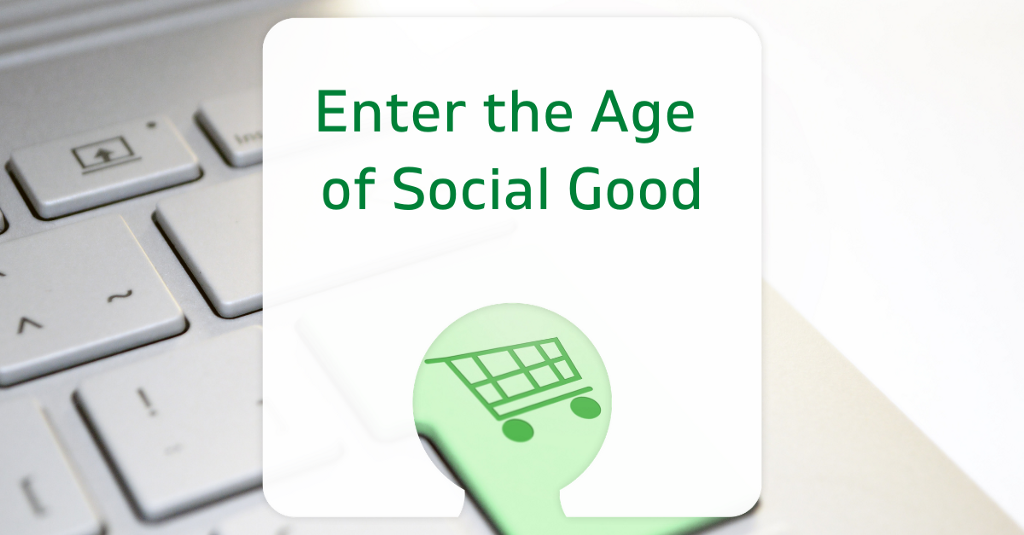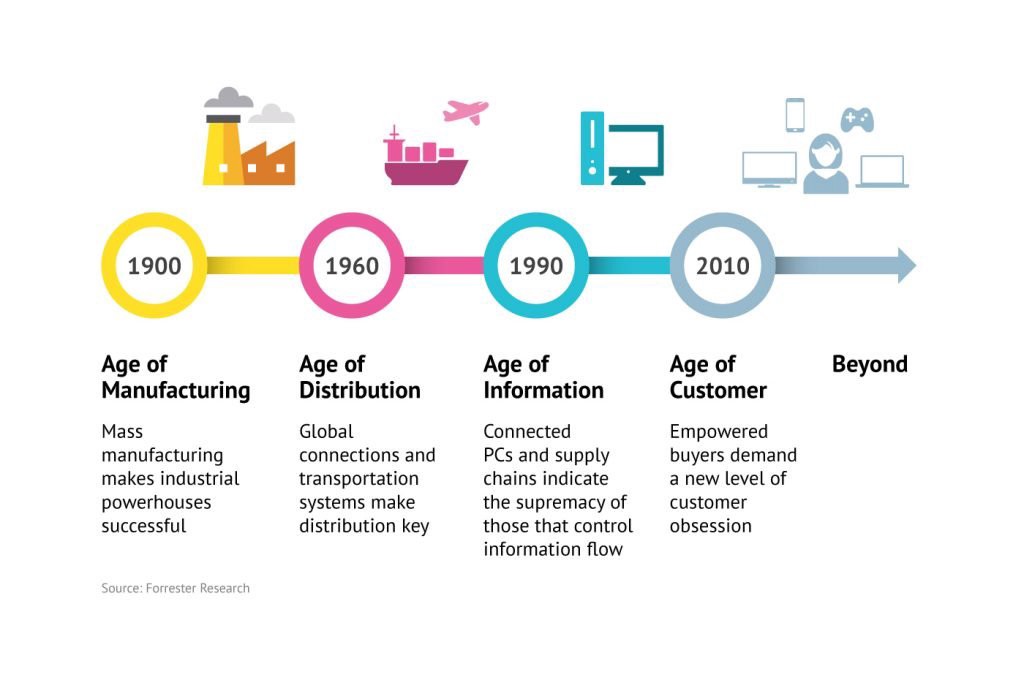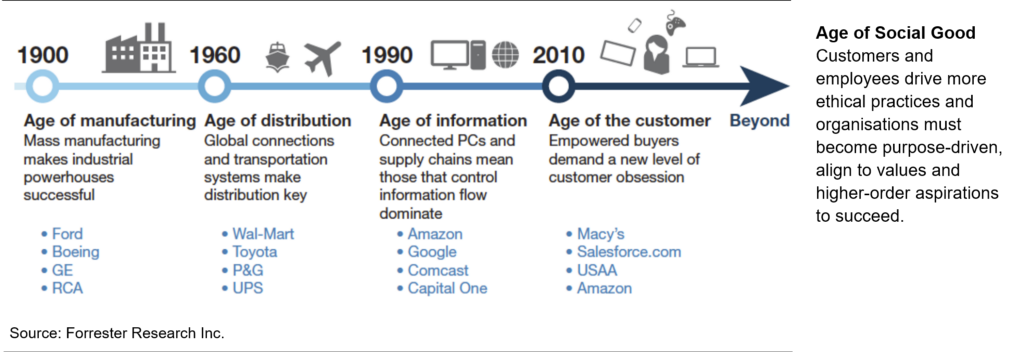Read this and get ready for it.

For many years now, I’ve been fascinated by the timeline shown below and pondering what lies beyond the Age of the Customer. These days, I’ve got a pretty good idea about what’s next.

First, let’s unpack this timeline and understand how we got to where we are today.
How we got here
This is a story about people with power. Specifically, the capital kind. Here is a very brief history of where that power has been located and how it’s shifted over time.
Many thanks to Clint Fontanella for their blog post explaining this timeline, which has informed my summary here.
In the Age of Manufacturing, the quality sellers rule the local markets
At the end of the Industrial Revolution, businesses with large manufacturing operations dominated. Products were purchased in stores or ordered from catalogs. You learned about reputable companies through word of mouth or local news sources. Products and the information about them were completely controlled by the seller. There was no way to distribute goods, so companies had to ensure that their products were high-quality to keep local customers satisfied and make them come back again.
In the Age of Distribution, businesses control the message
Modern transportation in the 60s allowed for the distribution of goods, increasing market reach for businesses. This prompted them to think globally, resulting in a greater focus on revenue and acquisition over customer satisfaction. When businesses made reputation-damaging mistakes, they could simply ignore the issue and focus their efforts elsewhere. They were also free to make any claims they wanted as they were in complete control of the message and there were no accountability mechanisms to keep them in check. Even though the buying decision was still in the control of the customer, these people were still at the mercy of businesses who controlled all the information.
In the Age of Information, power shifts to those who have access to the new information
In the 90s, the control of information began to shift, prompted by the rise of the internet. Forums and review sites allowed customers to learn about other products and businesses. However, this information was still not yet widely accessible or organised enough to cause impact to brands. The more clever companies started to listen to their customers’ needs, while the majority were devising ways to use the newly available information to simply acquire more customers.
In the Age of the Customer, the buyer’s experience is power
Starting around 2010, social media platforms enabled customers to share their experiences in real-time. The messaging was multi-directional, with customers creating their own content about products in conversation with the brands themselves. While these products (and services) were still controlled by the seller and the purchasing decision was still controlled by the customer, the access to information and the customer experience had now shifted to the customer too. Negative experiences were shared not just with the offending business (who previously had little accountability driving their response, if they had any), but with masses of other existing and potential customers. And in a way that mattered. Brands became increasingly accountable and those that didn’t pay attention to their customers’ wants and needs suffered the consequences.
Where we are today
Things have shifted quite a bit in the decade or more since the start of the Age of the Customer. Nowadays, social good is becoming an increasingly important driver of business success. As a result, we can see the rise of several social impact trends, such as companies promoting the number of CSR days they offer their staff, publication of carbon footprints, or promotion of the impact outcomes of their philanthropy tactics. Organisations are re-evaluating their DEI practices, developing ESG programs, diversifying and anonymising their hiring methods, switching to widespread sustainable ways of working and refocussing their core messaging around their ‘why’.
Where is this all taking us?
Welcome to the Age of Social Good

As customers share more experiences, desires and needs — and brands respond accordingly — the nature and nuances of the requests are changing. The power is shifting even further. Customers are comparing, evaluating, and choosing with considered intention. Brands are competing over smaller gains in tighter spaces. Furthermore, those choices are increasingly becoming customer identity statements, whether for personal reasons or performative displays of taste.
The landscape of gains over which the brands are competing are increasingly including higher-order aspirations, such as perceptions of ethical consumption or alignment with meaningful causes. Not only can most brands no longer get away with product decisions that are misaligned to their customers’ values, this need for accountability extends to their supply chains, their partnerships and the core messaging itself.
Where there wasn’t a why, now there must be. And it should resonate.
These reasons are reaching even beyond the bounds of the organisation and becoming inclusive of the wider world.
Who are our guides and helpers?
I often find wisdom in the legacy of Mr. Fred Rogers, who said the following:
When I was a boy and I would see scary things in the news, my mother would say to me, “Look for the helpers. You will always find people who are helping.” To this day, especially in times of disaster, I remember my mother’s words and I am always comforted by realizing that there are still so many helpers — so many caring people in this world.
— Mr. Fred Rogers
It may seem trite to reframe this discussion through the eyes of a child, but the metaphor fits. Not only for the infancy of this Age, but for the wonder which it holds. The leaders and visionaries in this new frontier are not the bold pioneers of the past, but rather the deep listeners of the future. We are customers, but we are people first. And as such, we all long to be heard, we want our space held, we need room to breathe. Our desires are both basic and aspirational.
And because people are also people who work at businesses, a specific kind of power has not only shifted externally to the customer, but also internally within the business. The accountability is increasingly coming from inside the house, by socially conscious human drivers of change. That’s a very good thing.
What we can do to get ready
We can all be helpers. We do this by becoming better at who we are, better at what we do, and better at how we influence others.
We must take small steps to raise our awareness and make incremental, meaningful changes as we grow into this new Age of Social Good.
The world depends on it.
The original version of this article was first published on my website at: https://www.witten.kim/blog/welcome-the-age-of-social-good
What comes after customer-centricity? was originally published in UX Collective on Medium, where people are continuing the conversation by highlighting and responding to this story.